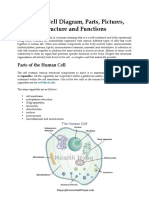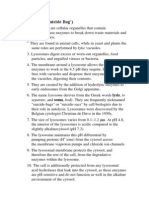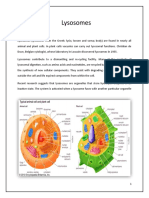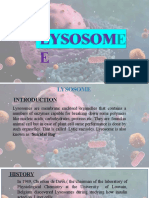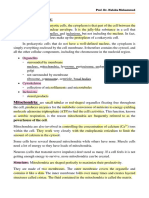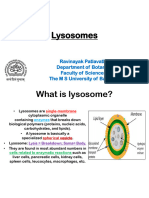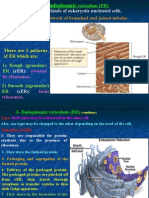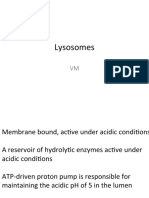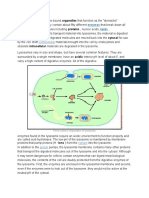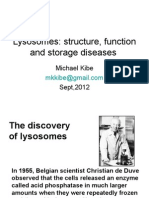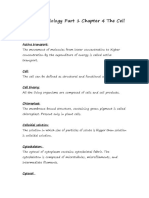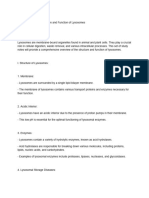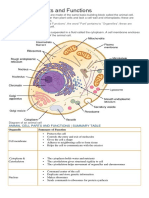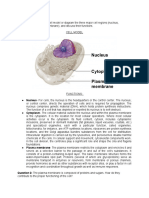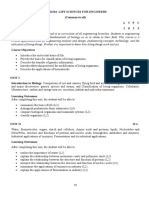Lisosom
Lisosom
Uploaded by
Anonymous O1xkZINCopyright:
Available Formats
Lisosom
Lisosom
Uploaded by
Anonymous O1xkZINOriginal Title
Copyright
Available Formats
Share this document
Did you find this document useful?
Is this content inappropriate?
Copyright:
Available Formats
Lisosom
Lisosom
Uploaded by
Anonymous O1xkZINCopyright:
Available Formats
The human body comprises about 50 to 75 trillion cells.
The cell is the smallest unit of life and is often called the building block of life. A single cell is made up of many different organelles, that have specific functions, such as the nucleus, Golgi bodies, mitochondria, peroxisomes and lysosomes. Lysosomes Lysosomes are membrane bound organelles that are found in the cytoplasm of both plant and animal cells. The word lysosome was derived from two Greek words, 'lysis' which means destruction or dissolution and 'soma' which means 'body'. Lysosomes were discovered in 1949, by a Belgian cytologist, Christian de Duve. Structure Lysosomes are actually membranous sacs filled with enzymes. They are found in all eukaryotic cells and act as 'garbage disposal' or the 'digester' of the cell. Lysosomes are spherical bag like structures that are bound by a single layer membrane, however, the lysosome shape and size may vary to some extent in different organisms. The lysosome size ranges between 0.1 to 1.2m. The membrane that surrounds the lysosome, protects the rest of the cell from the hydrolytic or digestive enzymes that are contained in the lysosomes. Lysosomes are manufactured by the Golgi apparatus, by budding, in the cell and the various digestive enzymes, that are present in the lysosomes are produced in the endoplasmic reticulum. These enzymes are then transported to the Golgi apparatus and are distributed to the lysosomes. Some examples of enzymes present in the lysosomes include nucleases, proteases, lipases and carbohydrases. These enzymes are used to dissolve nucleic acids, proteins, lipids and carbohydrates, respectively. All these enzymes are typically hydrolytic and can digest cellular macromolecules. Lysosomes are acidic, with a pH of 4.8. This acidic pH is maintained by pumping protons, from the cytosol that has a pH of 7.2. The protons are pumped across the membrane via proton pumps and chloride ion channels. The membrane thus acts as a protective barrier, that protects the cytosol and the rest of the cell from the hydrolytic enzymes within the lysosome. Function Lysosomes act as disposal system of the cell. They break down complex proteins,
carbohydrates, lipids and other macromolecules into simpler compounds. These simple compounds are returned to the cytoplasm and are used as new cell building materials. They are used for digestion of cellular waste products, dead cells or extracellular material such as foreign invading microbes, that pose a threat to the cell by phagocytosis process. However, phagocytosis is just one process that helps to get rid of unwanted material in the cell. Lysosomes are also involved in other digestive processes including endocytosis and autophagy. Another interesting function of the lysosomes is to repair the damage to the plasma membrane. They serve as membrane patch and help in sealing the wound in the plasma membrane. Lysosomes are also involved in programmed cell death, or autolysis, which is a catabolic process involving degradation of the cell's own components. This is the reason why lysosomes are often known as 'suicide sacs'. Defects Any malfunctioning of the lysosomes or any of the digestive proteins, results in lysosomal storage diseases, such as Tay-Sachs disease and Pompe's disease. These diseases are caused by defective function of the lysosomes or in absence of any of the digestive proteins or lysosomal hydrolytic enzymes. This was all about the structure of lysosome and its functions. So, now you know how important these microscopic organelles are! By Amruta Deshpande Read more at Buzzle: http://www.buzzle.com/articles/lysosome-structure.html
Lysosomes - Little Enzyme Packages
You will find organelles called lysosomes in nearly every animal-like eukaryotic cell. Lysosomes hold enzymes that were created by the cell. The purpose of the lysosome is to digestthings. They might be used to digest food or break down the cell when it dies. What creates a lysosome? You'll have to visit theGolgi complex for that answer. A lysosome is basically a specialized vesicle that holds a variety of enzymes. The enzyme proteins are first created in the rough endoplasmic reticulum. Those proteins are packaged in a vesicle and sent to the Golgi apparatus. The Golgi then does its final work to create the digestive enzymes and pinches off a small, very specific vesicle.
That vesicle is a lysosome. From there the lysosomes float in the cytoplasm until they are needed. Lysosomes are single-membrane organelles.
Lysosome Action
Since lysosomes are little digestion machines, they go to work when the cell absorbs or eats some food. Once the material is inside the cell, the lysosomes attach and release their enzymes. The enzymes break down complex molecules that can include complex sugars and proteins. But what if food is scarce and the cell is starving? The lysosomes go to work even if there is no food for the cell. When the signal is sent out, lysosomes will actually digest the cell organelles for nutrients.
Why Don't They Digest the Cell?
Here's something scientists are still trying to figure out. If the lysosome holds many types of enzymes, how can the lysosome survive? Lysosomes are designed to break down complex molecules and pieces of the cell. Why don't the enzymes break down the membrane that surrounds the lysosome?
You might also like
- Brock Biology of Microorganisms 13th Edition 140814191244 Phpapp01Document10 pagesBrock Biology of Microorganisms 13th Edition 140814191244 Phpapp01Anas Leo0% (1)
- Bontrager 9 EdicaoDocument339 pagesBontrager 9 EdicaoGerson Lopes100% (7)
- 0188e CHB OxygenDocument2 pages0188e CHB OxygenBebin Mathew83% (6)
- Animal Cell Parts and Functions - Summary TableDocument16 pagesAnimal Cell Parts and Functions - Summary TableAnnie Lyn Villamor100% (1)
- MnemonicsDocument4 pagesMnemonicsLheidaniel MMM.100% (2)
- Aluminum Toxicity in Mitochondrial Dysfunction and ASDDocument8 pagesAluminum Toxicity in Mitochondrial Dysfunction and ASDDr. Amy Yasko100% (6)
- Human Cell Diagram and Sickle CellDocument11 pagesHuman Cell Diagram and Sickle Cellaryaa2020No ratings yet
- Prener LC PDFDocument3 pagesPrener LC PDFAnonymous O1xkZINNo ratings yet
- PolycarbonateDocument12 pagesPolycarbonateAnonymous O1xkZINNo ratings yet
- The Acupuncture Point Book 1 50Document50 pagesThe Acupuncture Point Book 1 50mamun3175% (4)
- Miniongenetics 002Document2 pagesMiniongenetics 002api-366982317No ratings yet
- Insanity Workout Deluxe Calendar SimpleDocument1 pageInsanity Workout Deluxe Calendar SimpleAnonymous sTnEkqy4No ratings yet
- Lysosomes ( Suicide Bag')Document3 pagesLysosomes ( Suicide Bag')Andrew YengNo ratings yet
- LYSOSOMEDocument52 pagesLYSOSOMEDaniel Mendoza100% (1)
- Sir Syed University of Engineering and Technology: Assignment No 1Document10 pagesSir Syed University of Engineering and Technology: Assignment No 1Ali InamNo ratings yet
- Aini Discovery of LysosomesDocument15 pagesAini Discovery of LysosomesattiyaNo ratings yet
- LysosomesDocument15 pagesLysosomesIqra MujeebNo ratings yet
- LysosomeDocument16 pagesLysosomeMd. Ismail HosenNo ratings yet
- Cell Bio Library WorkDocument5 pagesCell Bio Library WorkJP SilvaNo ratings yet
- Cell Organeeles IDocument7 pagesCell Organeeles ISaumya GopalNo ratings yet
- LysosomeDocument8 pagesLysosomemir zaheeruddinNo ratings yet
- Group: Topic: LysosomeDocument2 pagesGroup: Topic: Lysosomelara23221No ratings yet
- Chapter - 5 Cell - The Fundamental Unit of Life - Class Ix Cbse - ScienceDocument34 pagesChapter - 5 Cell - The Fundamental Unit of Life - Class Ix Cbse - ScienceMadhav DayareNo ratings yet
- Animal Physiology Theory Lec1Document24 pagesAnimal Physiology Theory Lec1ao868598No ratings yet
- بايو م 2Document7 pagesبايو م 2alidoctor678No ratings yet
- Cell Structure and FunctionDocument38 pagesCell Structure and FunctionHyacinth RaeNo ratings yet
- Lysosomes: Semester - IiDocument14 pagesLysosomes: Semester - IiJyoti DasNo ratings yet
- EXAM 1 ObjectivesDocument9 pagesEXAM 1 ObjectivesNoslaidysNo ratings yet
- Lysosomes and Peroxisomes and GlyoxysomesDocument2 pagesLysosomes and Peroxisomes and Glyoxysomesalphabetagama713085100% (1)
- Biomed 04Document10 pagesBiomed 04api-3706483No ratings yet
- CellsDocument136 pagesCellsJake Paulo BelardoNo ratings yet
- Aryan Biochem FinalDocument11 pagesAryan Biochem Finalsspatel1512No ratings yet
- Lysosomes: Cell BiologyDocument20 pagesLysosomes: Cell BiologyBio SciencesNo ratings yet
- What Are Lysosomes?Document2 pagesWhat Are Lysosomes?Raj SharmaNo ratings yet
- Peta Konsep "SEL": Andika Satya Putra Xi Ipa 1 / 01Document26 pagesPeta Konsep "SEL": Andika Satya Putra Xi Ipa 1 / 01Andika SatyaNo ratings yet
- LysosomesDocument36 pagesLysosomessandhyagarg026No ratings yet
- Cell Class Viii - 3 CompetitiveDocument23 pagesCell Class Viii - 3 Competitiverajesh duaNo ratings yet
- Chapter 5 - The Fundamental Unit of Life: What Are Living Organisms Made Up Of?Document5 pagesChapter 5 - The Fundamental Unit of Life: What Are Living Organisms Made Up Of?HeroNo ratings yet
- CellDocument37 pagesCellAmber ZahidNo ratings yet
- Class 11 Biology Chapter 8 - Revision NotesDocument10 pagesClass 11 Biology Chapter 8 - Revision NotesHARKIRIT KAUR100% (1)
- It A System of Hollow Network of Branched and Joined TubulesDocument11 pagesIt A System of Hollow Network of Branched and Joined Tubulesapi-3706483No ratings yet
- Latin Organisms Cell Biology: Cells Are The Basic Building Blocks of All Living Things. The Human Body Is Composed ofDocument4 pagesLatin Organisms Cell Biology: Cells Are The Basic Building Blocks of All Living Things. The Human Body Is Composed ofmarshNo ratings yet
- LysosomesDocument20 pagesLysosomesRajesh SharmaNo ratings yet
- Cell OrganellesDocument10 pagesCell Organellessheenkaur2508No ratings yet
- The Cell: Types of CellsDocument4 pagesThe Cell: Types of CellsAllen MurilloNo ratings yet
- LysosomesDocument5 pagesLysosomespanigrahipuspanjali72No ratings yet
- LysosomeDocument21 pagesLysosomeMuskan WahabNo ratings yet
- Grade-9 Cbse Chapter-5 Revision NotesDocument14 pagesGrade-9 Cbse Chapter-5 Revision NotesNoel MammenNo ratings yet
- Cell - Physiology by MaifataDocument32 pagesCell - Physiology by Maifatastephenalfa7No ratings yet
- Lysosomes Are MembraneDocument2 pagesLysosomes Are MembranedevilNo ratings yet
- Cell Physiology-1Document32 pagesCell Physiology-1yoga karsendaNo ratings yet
- Revision Notes - Cell The Unit of LifeDocument3 pagesRevision Notes - Cell The Unit of LifetNo ratings yet
- 8.lysosomes, Structure and FunctionDocument50 pages8.lysosomes, Structure and Functionkubuldinho100% (3)
- Cell Asad NotesDocument23 pagesCell Asad NotesHess AhmedNo ratings yet
- The Body and Its ConstituentsDocument19 pagesThe Body and Its Constituentssantosh s u100% (1)
- Cell Organelles JigsawDocument10 pagesCell Organelles JigsawSusan VictoriaNo ratings yet
- Chapter 5 The Fundamental Unit of LifeDocument5 pagesChapter 5 The Fundamental Unit of LifeDHAIRYA KASAR100% (1)
- The Fundamental Unit of LifeDocument137 pagesThe Fundamental Unit of LifeSudarshan S KNo ratings yet
- CELL-THE UNIT OF LIFE - LysosomesDocument9 pagesCELL-THE UNIT OF LIFE - LysosomesHridyanshu Singh RoyNo ratings yet
- MH 09 SC CH05 Cell The Unit of LifeDocument35 pagesMH 09 SC CH05 Cell The Unit of Lifeshreyakabade07No ratings yet
- The Fundamental Unit of LifeDocument12 pagesThe Fundamental Unit of LifeTanish JenaNo ratings yet
- Cell NursingDocument83 pagesCell NursingRocKyRiazNo ratings yet
- Cytoplasm 2.: Cell OrganellesDocument6 pagesCytoplasm 2.: Cell OrganellesSai Deekshita VijayakumarNo ratings yet
- Cell and Its OrganellesDocument12 pagesCell and Its OrganellesIrish Mae FirmezaNo ratings yet
- Cell OrgenellesDocument10 pagesCell OrgenellesShruti TiwariNo ratings yet
- Cell Membrane: Apparatus Proteins Lipids Vesicles Cytoplasm Endoplasmic Reticulum Cell Nucleus Cells PlantDocument3 pagesCell Membrane: Apparatus Proteins Lipids Vesicles Cytoplasm Endoplasmic Reticulum Cell Nucleus Cells PlantPauline Grace MontifalconNo ratings yet
- Structure and Function of LysosomesDocument3 pagesStructure and Function of Lysosomesuserdev987No ratings yet
- Cell Biology Lec No 11 LysosomeDocument19 pagesCell Biology Lec No 11 LysosomesaleemNo ratings yet
- JetDocument14 pagesJetAnnie Lyn VillamorNo ratings yet
- Japan Trip 2017 (Tokyo)Document60 pagesJapan Trip 2017 (Tokyo)Anonymous O1xkZINNo ratings yet
- Nmacc 2 Go 15 MarDocument2 pagesNmacc 2 Go 15 MarAnonymous O1xkZINNo ratings yet
- Quick Changeover SmedDocument33 pagesQuick Changeover SmedAnonymous O1xkZINNo ratings yet
- Pengumuman Lolos ADM WebDocument7 pagesPengumuman Lolos ADM WebAnonymous O1xkZINNo ratings yet
- Pdo 4Document10 pagesPdo 4Anonymous O1xkZINNo ratings yet
- Graduate Resume PDFDocument2 pagesGraduate Resume PDFAnonymous O1xkZINNo ratings yet
- Michaelis Manten KineticsDocument8 pagesMichaelis Manten KineticsAnonymous O1xkZINNo ratings yet
- Product DesignDocument64 pagesProduct DesignAnonymous O1xkZINNo ratings yet
- BPEdDocument35 pagesBPEdsashi010No ratings yet
- ICD-10 v1.2Document978 pagesICD-10 v1.2Frita Oktina WijayaNo ratings yet
- Question 1: Identify On A Cell Model or Diagram The Three Major Cell Regions (NucleusDocument10 pagesQuestion 1: Identify On A Cell Model or Diagram The Three Major Cell Regions (NucleusGracea Mae AranetaNo ratings yet
- Thyroid & Parathyroid GlandsDocument21 pagesThyroid & Parathyroid GlandsAzizan HannyNo ratings yet
- Bioenergetics and Biological Oxidation FinalDocument27 pagesBioenergetics and Biological Oxidation Finalapi-19859346No ratings yet
- Procedures of The Cervical and Thoracic SpineDocument28 pagesProcedures of The Cervical and Thoracic SpinemiracleNo ratings yet
- MYOCARDITIS PPT NewDocument27 pagesMYOCARDITIS PPT Newsanta_pangaribuan_1100% (3)
- Syllabus CSE Life Science For EngineersDocument2 pagesSyllabus CSE Life Science For Engineersgopinadh reyyaNo ratings yet
- 3D Cell Culture Fundamentals and Applications in Tissue Engineering and Regenerative Medicine 2018Document227 pages3D Cell Culture Fundamentals and Applications in Tissue Engineering and Regenerative Medicine 2018Oscar LarezNo ratings yet
- Mitral ValveDocument48 pagesMitral Valvesinghal296% (23)
- General Biology I: Quarter 1 - Module 1: The CellDocument26 pagesGeneral Biology I: Quarter 1 - Module 1: The Cellsecurity check upNo ratings yet
- 2009 Anatomy MCQsDocument10 pages2009 Anatomy MCQsAndrew Kalaw100% (2)
- Genetics - Bio 12 UP Diliman ReviewerDocument7 pagesGenetics - Bio 12 UP Diliman ReviewerAnne Sharmaine OchoaNo ratings yet
- Weaving It Together 1 - Unit 3 - Sleep.Document13 pagesWeaving It Together 1 - Unit 3 - Sleep.THINo ratings yet
- J A S E M .: Palm Oil, Its Nutritional and Health Implications (Review) Imoisi, Ob Ilori, Ge Agho, I. Ekhator, JoDocument7 pagesJ A S E M .: Palm Oil, Its Nutritional and Health Implications (Review) Imoisi, Ob Ilori, Ge Agho, I. Ekhator, JomirnaNo ratings yet
- Mcqs Emqs in Human Physiology Asm2016 Virtual Library PDFDocument361 pagesMcqs Emqs in Human Physiology Asm2016 Virtual Library PDFMohammad Yasir0% (1)
- Chapter 1 Properties and Overview of Immune ResponsesDocument45 pagesChapter 1 Properties and Overview of Immune Responses13701319477No ratings yet
- Board Notes and QuestionsDocument481 pagesBoard Notes and QuestionsAnil S. BhavsarNo ratings yet
- Investigatory Project ON: Bhagwati International Public SchoolDocument23 pagesInvestigatory Project ON: Bhagwati International Public SchoolDhairya PatelNo ratings yet
- Modul Science Form 2Document36 pagesModul Science Form 2AJ MukunNo ratings yet
- An Evolutionary Theory of Human Motivation - Bernard Et Al (2005)Document57 pagesAn Evolutionary Theory of Human Motivation - Bernard Et Al (2005)Eduardo Aguirre DávilaNo ratings yet
- Phenological Growth Stages of Edible Asparagus (Asparagus To The BBCH ScaleDocument7 pagesPhenological Growth Stages of Edible Asparagus (Asparagus To The BBCH Scalerudy cab kuNo ratings yet






